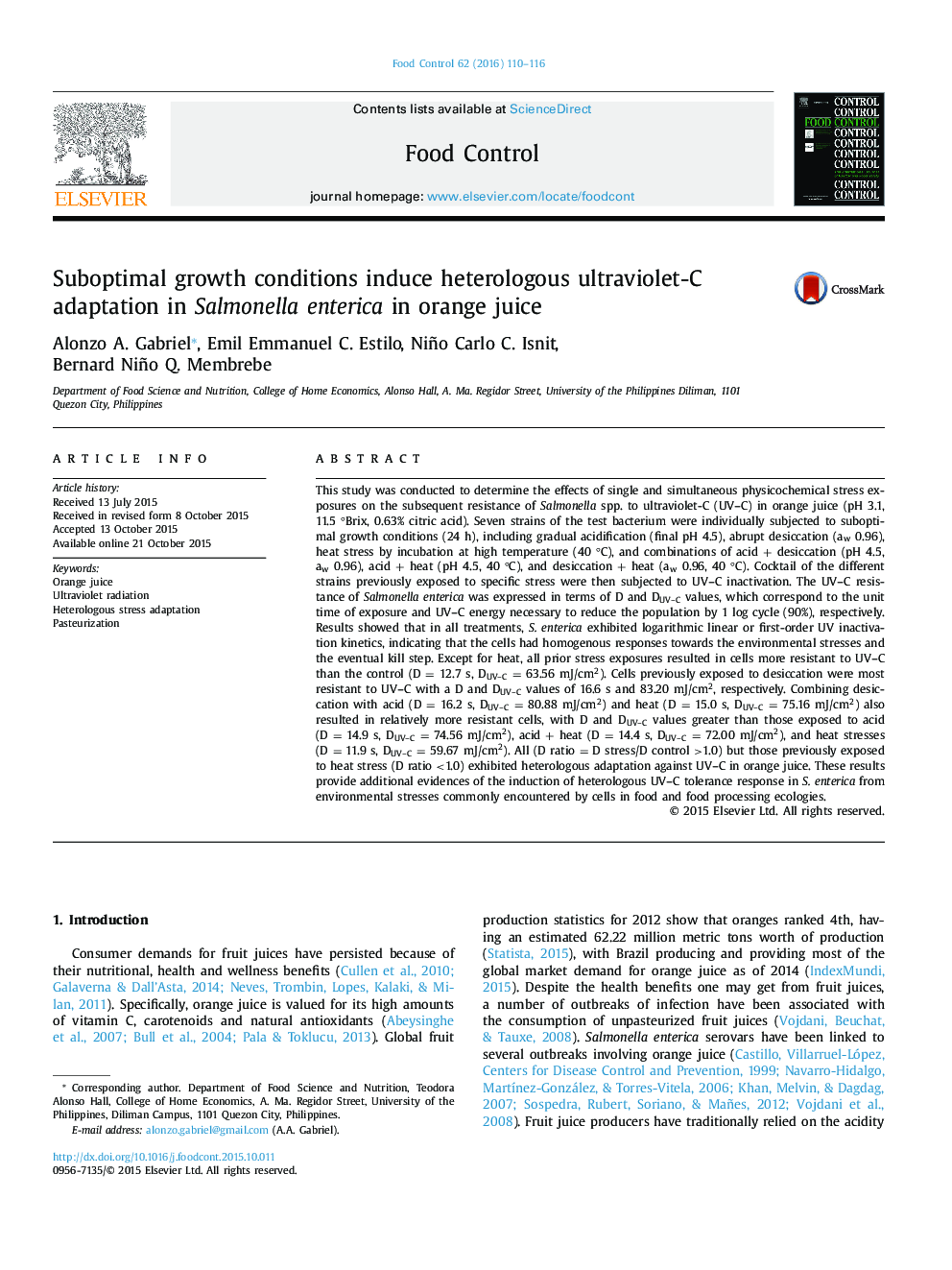| کد مقاله | کد نشریه | سال انتشار | مقاله انگلیسی | نسخه تمام متن |
|---|---|---|---|---|
| 6390410 | 1628400 | 2016 | 7 صفحه PDF | دانلود رایگان |
عنوان انگلیسی مقاله ISI
Suboptimal growth conditions induce heterologous ultraviolet-C adaptation in Salmonella enterica in orange juice
دانلود مقاله + سفارش ترجمه
دانلود مقاله ISI انگلیسی
رایگان برای ایرانیان
کلمات کلیدی
موضوعات مرتبط
علوم زیستی و بیوفناوری
علوم کشاورزی و بیولوژیک
دانش تغذیه
پیش نمایش صفحه اول مقاله

چکیده انگلیسی
This study was conducted to determine the effects of single and simultaneous physicochemical stress exposures on the subsequent resistance of Salmonella spp. to ultraviolet-C (UV-C) in orange juice (pH 3.1, 11.5 °Brix, 0.63% citric acid). Seven strains of the test bacterium were individually subjected to suboptimal growth conditions (24 h), including gradual acidification (final pH 4.5), abrupt desiccation (aw 0.96), heat stress by incubation at high temperature (40 °C), and combinations of acid + desiccation (pH 4.5, aw 0.96), acid + heat (pH 4.5, 40 °C), and desiccation + heat (aw 0.96, 40 °C). Cocktail of the different strains previously exposed to specific stress were then subjected to UV-C inactivation. The UV-C resistance of Salmonella enterica was expressed in terms of D and DUV-C values, which correspond to the unit time of exposure and UV-C energy necessary to reduce the population by 1 log cycle (90%), respectively. Results showed that in all treatments, S. enterica exhibited logarithmic linear or first-order UV inactivation kinetics, indicating that the cells had homogenous responses towards the environmental stresses and the eventual kill step. Except for heat, all prior stress exposures resulted in cells more resistant to UV-C than the control (D = 12.7 s, DUV-C = 63.56 mJ/cm2). Cells previously exposed to desiccation were most resistant to UV-C with a D and DUV-C values of 16.6 s and 83.20 mJ/cm2, respectively. Combining desiccation with acid (D = 16.2 s, DUV-C = 80.88 mJ/cm2) and heat (D = 15.0 s, DUV-C = 75.16 mJ/cm2) also resulted in relatively more resistant cells, with D and DUV-C values greater than those exposed to acid (D = 14.9 s, DUV-C = 74.56 mJ/cm2), acid + heat (D = 14.4 s, DUV-C = 72.00 mJ/cm2), and heat stresses (D = 11.9 s, DUV-C = 59.67 mJ/cm2). All (D ratio = D stress/D control >1.0) but those previously exposed to heat stress (D ratio <1.0) exhibited heterologous adaptation against UV-C in orange juice. These results provide additional evidences of the induction of heterologous UV-C tolerance response in S. enterica from environmental stresses commonly encountered by cells in food and food processing ecologies.
ناشر
Database: Elsevier - ScienceDirect (ساینس دایرکت)
Journal: Food Control - Volume 62, April 2016, Pages 110-116
Journal: Food Control - Volume 62, April 2016, Pages 110-116
نویسندگان
Alonzo A. Gabriel, Emil Emmanuel C. Estilo, Niño Carlo C. Isnit, Bernard Niño Q. Membrebe,